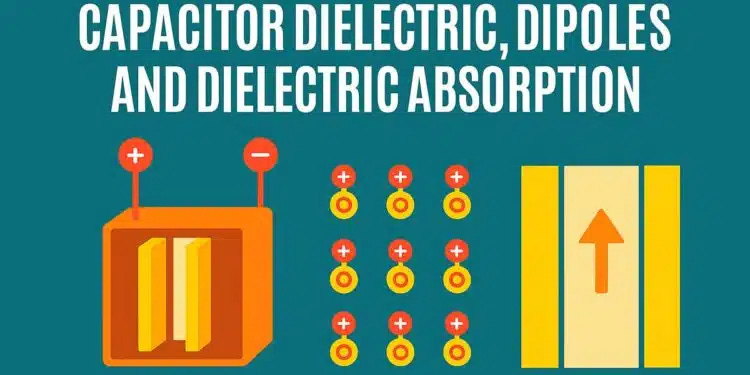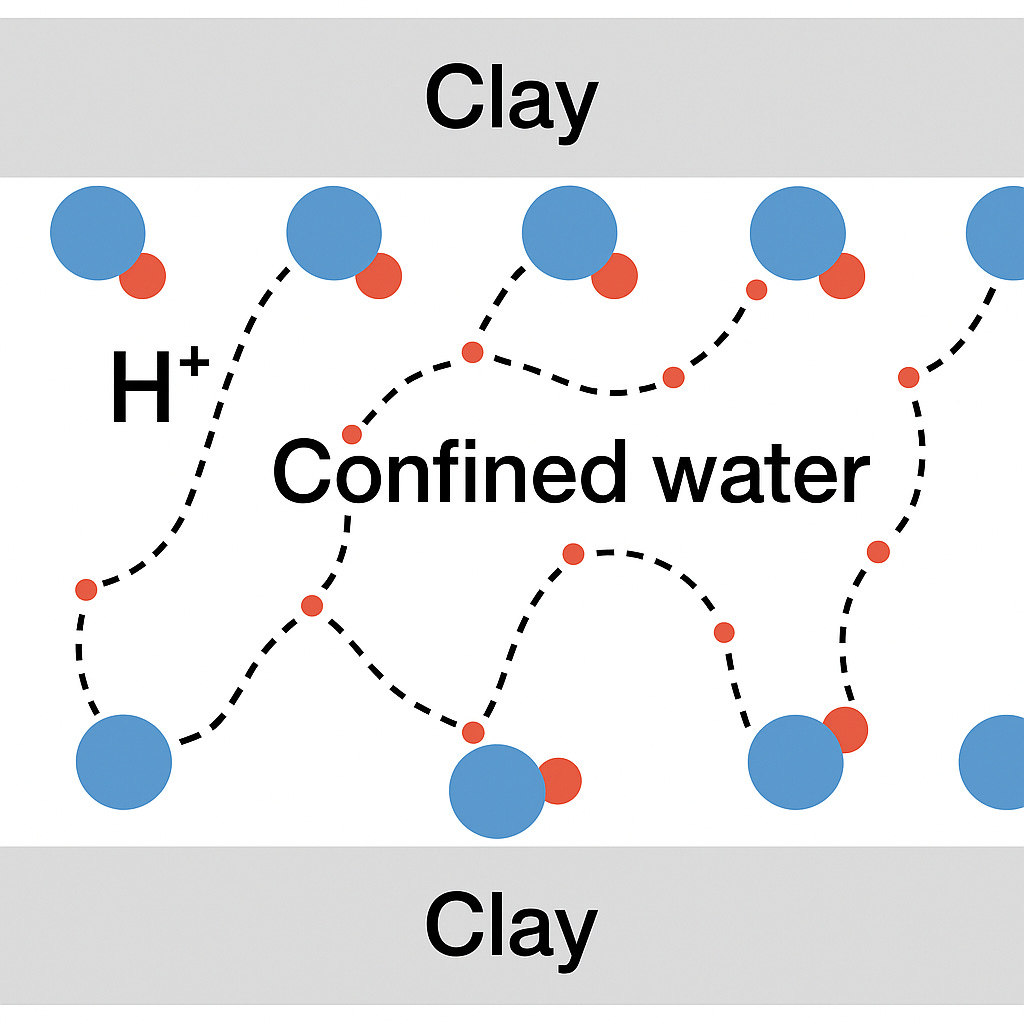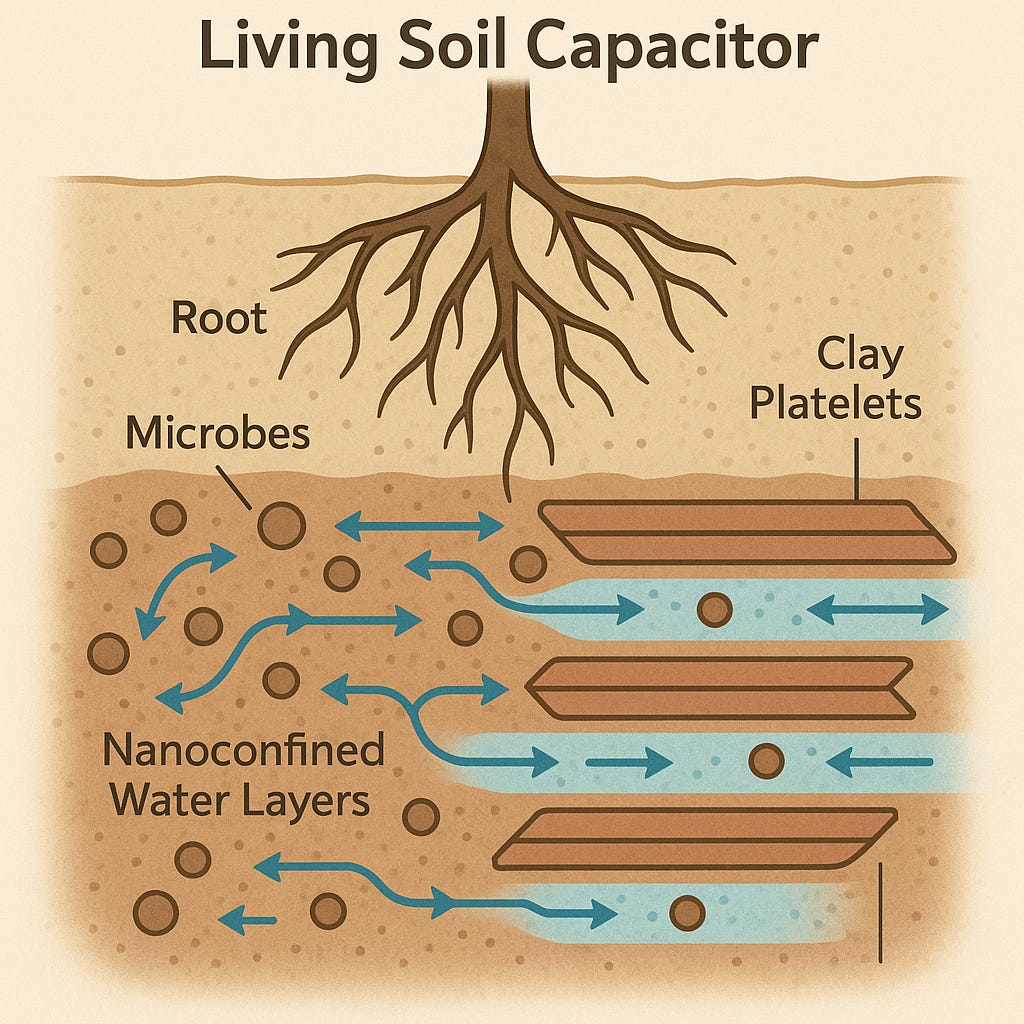Electricity, Water and Soils
Challenging Long-Held Assumptions About Clay & Water
It has been sometime since our last post and this is because of our deeper research into some “bleeding edge” studies on water, electrical energy and soils. This research could change many of our perspectives on how we manage and use our soil systems and in particular, clay and below ground electrical energy
Overview
This section is quite long, however it is important to go over the background to this posting which all started with our reading an article in Nature, which we are linking to here, in several places. What really caught our attention is the possible ramifications of these findings and how these could apply to clay soils and moisture.
For decades, water has been treated as having a fairly constant dielectric constant (≈ 80 at room temp). This study shows that when confined between atomically flat walls to just a few nanometers (especially 1–2 nm thick), water’s in-plane dielectric constant jumps by an order of magnitude — exceeding 1000.
What “Dielectric” Means — Simply Explained
A dielectric is any material that does not conduct electricity freely but responds to electric fields by shifting its internal charges slightly.
In other words:
A dielectric resists charge flow, but its molecules polarize when an electric field is applied.
That polarization reduces the field inside the material and allows the material to store electrical energy — which is why dielectrics are central to capacitors, insulators, and biological membranes alike.
The dielectric constant (also called relative permittivity, εᵣ) measures how easily a material polarizes in response to an electric field.
Vacuum: εᵣ = 1
Air: ≈ 1.0006 (almost same as vacuum)
Glass: ~ 4–10
Water (bulk): ≈ 80 at room temperature
So water’s dielectric constant is huge compared to most materials — it can bend and absorb electrical fields, shielding charges from each other. That’s why salts dissolve easily in water: its high ε screens electrostatic attraction between ions.
Polarization at the Molecular Level
Water’s high ε comes from its dipolar molecules — each with a slightly positive side (hydrogens) and a slightly negative side (oxygen).
When an electric field is applied, water molecules rotate and align, forming “microscopic electric shields.”
This reorientation is rapid (on picosecond timescales) and underpins:
Electrolyte behavior
Hydrogen bonding dynamics
Proton hopping and ion transport
Now — the Nature paper shows that when water is confined to a 1–2 nm film between atomically smooth walls, its in-plane dielectric constant ε// doesn’t just stay high… it skyrockets to over 1,000.
That means:
The water film becomes ultra-polarizable — like a “liquid capacitor plate.”
Its ability to screen or transmit fields laterally is far beyond bulk water.
It might even approach ferroelectric-like behavior (where dipoles align cooperatively and persistently).
In such a system, the “dielectric” is no longer passive — it interacts with and amplifies electric fields.
Dielectric vs. Conductivity
Normally, materials are either:
Conductors: electrons or ions move freely (metals, saltwater)
Insulators/Dielectrics: charges stay bound, only polarize locally
There is further information on this here.
But this Nature paper found both an extremely high dielectric constant and strong in-plane conductivity — meaning confined water behaves as a polarizable, proton-conducting quasi-liquid.
This breaks the old dichotomy between “conductor” and “insulator.” The confinement of water has some really important consequences when it comes to soils which we will return to soon. Let’s expand on this a little.
Step-by-step explanation
1. “Confined water”
This means water that is trapped in very tiny spaces — such as between layers of clay, inside nanopores of rocks, in cell membranes, or within soil particles.
In these spaces, the water molecules can’t move freely as they do in bulk liquid water. Their arrangement and behavior are influenced by nearby surfaces and electric fields.
2. “Polarizable”
Water molecules are dipoles — each has a positive end (hydrogen side) and a negative end (oxygen side). “Polarizable” means that these dipoles can easily shift or re-orient when an external electric field or nearby charged surface acts on them.
In confined water, this ability to shift orientation is enhanced or modified because the molecules are lined up or restricted by the boundaries around them. So, confined water can store and respond to electric fields differently than normal water — it’s like a dynamic capacitor at the nanoscale.
3. “Proton-conducting”
Protons (H⁺ ions) can hop rapidly between water molecules via a mechanism called the Grotthuss mechanism — a sort of “bucket brigade” of hydrogen bonds passing the proton along. In confined spaces, this hopping can become more efficient or directional. That means confined water can act a bit like a wire for protons, conducting charge through hydrogen bonds instead of electrons through metal.
4. “Quasi-liquid”
“Quasi” means “almost but not quite.”
So “quasi-liquid” means it behaves partly like a liquid (molecules can move and flow) but partly like a solid (molecules are ordered and restricted). In confinement, water might look like a gel or an ordered sheet — not frozen, but not freely flowing either.
We created an article here on the phases of water.
In plain terms
When water is squeezed into extremely tiny spaces — like between clay layers or in biological channels — it stops acting like ordinary liquid water.
Instead, it becomes an almost-liquid material that:
Holds and responds to electric charge (polarizable),
Transports protons very efficiently (proton-conducting),
Maintains partial order (quasi-liquid).
Why it matters
This “confined water” behavior is important in:
Soil science: It helps explain how moisture and charge move in clay-rich soils.
Electrochemistry & batteries: Proton transport through membranes (like in fuel cells).
Biology: Ion channels and enzyme hydration layers rely on this property.
Energy and environmental systems: It affects how minerals, microbes, and electric currents interact underground or in nanomaterials.
Clay-Rich, Not Clay-Heavy
The narrative of “clay as a problem” has been repeated for decades, mostly by gardeners and landscapers working from a top-down, short-term mindset. But viewed through the lens of physics, ecology, and electrochemistry, clay-rich soils are not “bad” — they’re energetically sophisticated.
Why Our Soils Store Life and Energy
For generations, people have complained that “clay soils are hard to work.”
They hold water, crack when dry, and bog down machinery.
But this new science — and old ecological wisdom — tell a possibly different story.
Clay Is Alive With Energy
Each particle of clay is a microscopic plate with an electric charge.
Between those plates lie ultra-thin water films, only a few molecules thick.
Recent research shows that in these films, water behaves differently —
its dielectric constant (ability to store electrical energy) can rise to over 1,000.
That means:
Clay doesn’t just hold moisture — it stores electrochemical potential.
It acts like a natural battery, regulating charge, moisture, and nutrient flow.
Clay-Rich = Energy-Rich
Old View - “Clay soils are heavy and wet.
New Understanding - ”Clay soils stabilize moisture and buffer droughts.
Old View - “They trap nutrients.”
New Understanding - Clay retains and releases nutrients through electrical exchange.
Old View - “They’re cold and slow.
New Understanding - ”Clay tempers temperature swings, protecting microbes and roots.
Old View - “They’re hard to till.
New Understanding - ”Clay builds structure naturally when joined with roots and humus.
The Living Soil Capacitor
When combined with compost, roots, and mycorrhizal fungi,
clay minerals create a living network that:
Moves protons and ions laterally through moisture films,
Feeds plants more evenly,
Extends microbial life deeper into dry periods.
Your soil becomes a resilient, slow-breathing capacitor — storing and releasing life’s current.
What We Can Do?
Avoid over-tilling: preserve micro-layer structure.
Add organic matter: humus links clay platelets into flexible aggregates.
Mulch and compost: keep water films intact.
Plant deep-rooted perennials: they “wire” the system together.
Celebrate your clay-rich ground: it’s nature’s own energy bank.
As always, thank you for reading this article and please feel free to post comments, questions and share this if you feel it worthy to do so.




